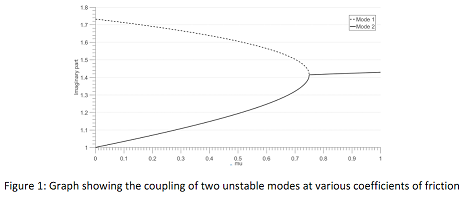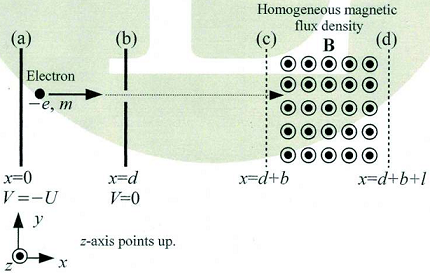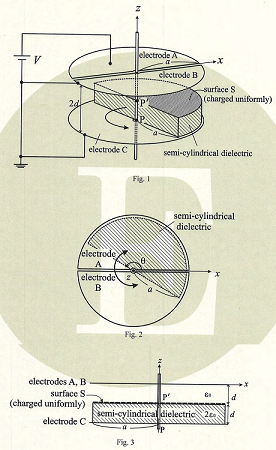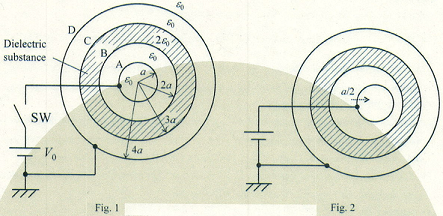Reference no: EM131207754
Problem 1 - As shown in Fig. 1, there is a sufficiently thin square coil A of side length 2a and of winding number N in a medium with magnetic permeability μ0 on the xy-plain. Its center is at the origin O of the xyz-space. There is a fine line conductor B which is infinitely long in the y-direction at x = -b and z = 0, where b > a > 0. A constant current IB flows in the y-direction from positive to negative in conductor B. Let us assume that the magnetic permeability of these conductors is also μ0.
(1) Find the magnetic flux density B(x) produced by IB at a point P (x, y, 0), where x ≠ -b, on the xy-plain in Fig. 1.
(2) A constant current IA flows in coil A as shown in Fig. 1. Find the magnetic force dF acting on a line element vector ds in coil A. The direction of ds is identical to that of the coil current.
(3) Find the magnitude and the direction of the fame acting on coil A based on the result of Question (2).
(4) Find the magnetic flux produced by current IB and linked to coil A.
(5) Find the mutual inductance between coil A and line conductor B.
(6) Find the magnitude and the direction of the force between coil A and line conductor B based on the virtual displacement principle using the result of Question (5).

Problem 2 - An electron, whose electric charge and mass are -e (e > 0) and tn. respectively, is accelerated between a pair of sufficiently large parallel plate electrodes (a) and (b) in Fig. The initial position of the electron is at (a) and the initial velocity v0 of the electron is zero at t = 0. The electric potential of the plate electrode (a) is -U < 0. This electron passes through a small hole at the plate electrode (b), whose voltage is 0, runs straight in the region between (b) and (c), and enters the region between (c) and (d), where homogeneous magnetic flux density B =(0, 0, B), where B ≥ 0, is applied in z-direction. This region of homogeneous magnetic flux is infinitely large in y-direction and has a length of l in x-direction. The whole setup is placed in a vacuum. No resistance force is applied on the moving electron. Effects caused by the moving electron on the magnetic flux density are negligible.
(1) Find the time and the speed of the electron when it passes through the electrode (b).
(2) Find the condition that the electron reaches the right-hand side of the boundary (d).
(3) Find the speed of the electron at the time when it passes through the boundary (d).
(4) Find the angle of the electron trajectory to the x-axis when the electron passes through the boundary (d).
(5) Find the time when the electron passes through the boundary (d). You can use inverse trigonometric functions here.
(6) Explain what happens when the magnetic flux density between the boundaries (c) and (d) does not meet the condition obtained in Question (2).
(7) The trajectory of the electron varies depending on the magnetic flux density B. However, there is a region(s) where the electron can never pass. Illustrate the region(s) graphically.

Problem 3 - As shown in Fig. 1, semicircular disc electrodes A and B of radius a and a circular disc electrode C of radius a are placed horizontally in vacuum, keeping a distance 2d . The centers of the electrodes are located on the z axis. The semicircular disc electrodes A and B are insulated from each other with a negligibly small slit. A voltage V is applied to the electrode A, and the electrodes B and C are grounded.
There is a semi-cylindrical dielectric on the electrode C. This semi-cylindrical dielectric corresponds to a half of a cylinder whose central axis is P- P'. The radius, the thickness, and the relative permittivity of the semi-cylindrical dielectric are a, d, and 2, respectively. The P -P' axis is aligned with the z axis. The semi-cylindrical dielectric has an insulating axial rod with a negligible mass through P - P' and can rotate smoothly about the z axis on the electrode C. The upper surface (surface S) of the semi-cylindrical dielectric is uniformly charged with its true surface charge density σ.
Figures 2 and 3, respectively, show the top and the front views of the electrode configuration. The x axis is chosen along the slit between the electrodes A and B. Let the rotating angle of the semi-cylindrical dielectric from the x axis be θ. The permittivity of vacuum is ε0. Here, a >> d holds. Ignore fringing of the fields and effects of the gravity. Answer the following questions.
(1) When θ is set to π, i.e. the semi-cylindrical dielectric is located just below the electrode A, the potential on the surface S is 2V/3. Find the electric fields in vacuum and in the dielectric between the electrodes A and C.
(2) In Question (1), find the true surface charge density, σ, and the polarization surface charge density σp on the surface S.
(3) Find the potential on the surface S, when θ is set to 0, i.e. the semi-cylindrical dielectric is located just below the electrode B.
(4) Find the electrostatic energy stored in the system when θ is θ0. Here, assume 0 ≤ θ0 ≤ π.
(5) In Question (4), find the torque acting on the semi-cylindrical dielectric with respect to the z axis by utilizing the virtual work method.
(6) The semi-cylindrical dielectric starts rotating at θ = θ0 from rest. Determine the angle θ and the angular velocity ω as a function of time t, and plot them against 1. Here, suppose θ = θ0 and ω = 0 at t = 0, and the moment of inertia about the z axis of the semi-cylindrical dielectric is I. Ignore friction and electromagnetic wave generation. Hint: For a rigid body rotating about a fixed axis, the following equation holds:
I(dω/dt) = N,
where I is the moment of inertia about the axis of the rotation, ω is the angular velocity, and N is the torque.

Problem 4 - A concentric spherical capacitor is formed by infinitely-thin spherical conducting shells A, B, C, and D having radii a, 2a, 3a, and 4a, respectively, as shown in Fig 1. The shell D is grounded. The space between the shells B and C is filled with a dielectric substance of permittivity 2ε0. Other spaces are in vacuum of permittivity ε0. The dielectric substance is not an ideal insulator, but has quite a small conductivity. The switch SW is open and the charges on the shells A, B, C, and D are zero. Now, the switch SW is closed to apply a voltage V0 between the shells A and D. Immediately after the switch is closed, the charges on the shells A, B, C, and D become Q0, 0, 0, and -Q0, respectively. This time is defined as t = 0. Then, at t > 0, a leakage current flows in the dielectric substance due to the electric field in the dielectric substance. After a sufficiently long time, the electric field in the dielectric substance becomes zero. Answer the following questions.
(1) Express the electric field strength at a distance r from the center of the spherical shells at t = 0 in terms of ε0, r, and Q0.
(2) Find the relation between Q0 and V0. Then, express the electrostatic energy U0 of the capacitor at t = 0 in terms of ε0, a, and V0.
(3) After a sufficiently long time, the electrostatic energy of the capacitor becomes U∞. Express the change in the electrostatic energy from t = 0, i.e. U∞ - U0, in terms of ε0, a, and V0.
(4) Find the energy Ws, supplied from the power source in Fig 1. and the Joule heating energy Wj generated in the dielectric substance after the sufficiently long time from t = 0. Express Ws and Wj in terms of ε0, a, and V0.
(5) After (4), the shell A is moved from the center by a/2, as shown in Fig. 2. After a sufficiently long time, the electric field in the dielectric substance becomes zero again due to the leakage current in the dielectric substance. Sketch the electric lines of force inside the capacitor after the electric field in the dielectric substance becomes zero.
(6) In (5), what is the direction of electrostatic force exerted on the shell A? Explain the reason.
